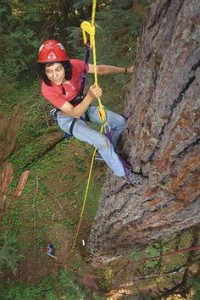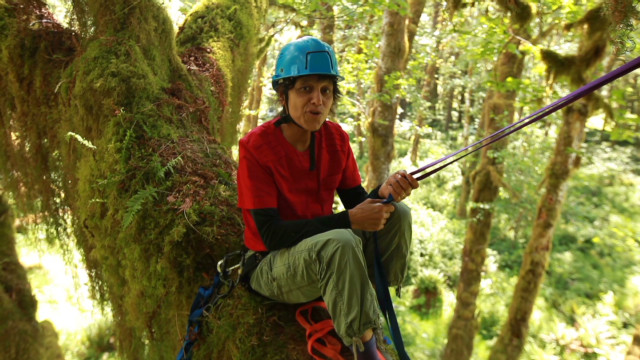Life in the Canopy
Posted in People on March 25 2014, by Sonia Uyterhoeven
Sonia Uyterhoeven is the NYBG’s Gardener for Public Education.
 While attending New England Grows—a regional tradeshow and educational forum that takes place in Boston each year—I was lucky enough to hear the ecologist and public spokesperson, Nalini Nadkarni, give a lecture on rain forest ecology and its importance as a biological system.
While attending New England Grows—a regional tradeshow and educational forum that takes place in Boston each year—I was lucky enough to hear the ecologist and public spokesperson, Nalini Nadkarni, give a lecture on rain forest ecology and its importance as a biological system.
Dr. Nadkarni’s research was not conducted on the forest floor, but rather at great heights above it. She quite literally harnessed the tools of the arborist’s trade and hoisted herself and a team of researchers 100 feet up in the air to explore the biological communities that thrived in the upper layers of the rain forest’s canopy.
Up in the treetops, Nadkarni and her team found a surprising diversity. The plants they came upon were expected: orchids, bromeliads, ferns, mosses, and lichens. These epiphytic plants are an important component of tropical arboreal communities, surviving and thriving by collecting water and nutrients from rainfall trapped in their foliage. What surprised the researchers, however, was the complexity of the arboreal ecosystem.
The researchers found up to 10 inches of soil on the branches of healthy communities over 100 feet above the ground. The soil was largely composed of organic matter left by decomposing plants. Nadkarni described finding “pecks and bushels” of soil on large branches, full of treetop versions of organisms typically found in terrestrial soils. This included springtails, ants, spiders, and even earthworms.
These arboreal communities play an important role in tropical rain forests. Studies have shown that birds in the cloud forests of Costa Rica use the flowers and fruits of epiphytes for over a third of their foraging. These supportive communities also help stabilize what would otherwise prove a harsh environment. The dense plant cover keeps the temperatures cooler, resulting in less water loss through evaporation.
Epiphytes capture nitrogen and other nutrients from rain, mist, and dust, and are able to “fix” gaseous nitrogen into nitrate and ammonium—two forms of nitrogen that are readily used by plants and animals. Studies have shown that 60% of all nitrates entering the ecosystem via rain and mist are held in the canopy by branch-dwelling mosses. These mosses perform a keystone function in this community, providing a foundation for other plants to successfully colonize.
As part of their study, the team stripped a section of vegetation away from a branch. They expected to find the section quickly recolonized by plants, but the arboreal ecosystem proved incredibly fragile. It took 12 years for the moss to start growing back, and after 22 years it had only recovered to 50% of its former state.

Nadkarni has since embarked on an innovative campaign to increase awareness of the importance of these fragile ecosystems. In addition to her scientific research in Costa Rica and Washington State, she has adopted the role of a public spokesperson. She has authored pamphlets with religious institutions discussing the spiritual value of the world’s flora, connecting it to references in religious texts and providing information on the biology and identification of local trees. She’s further created initiatives involving prisoners in conservation projects (one was a study of moss growth rates) and helped launch a program that trains convicts to be arborists, ensuring marketable skills upon their release.
She even teamed up with a rapper to co-author a song in an effort to get children interested in trees. (I heard the song—it was wonderful!)
My personal favorite among Nadkarni’s many outreach projects was her attempt to conquer the commercial world. Reaching out to the toy industry, she came up with the idea of “Tree Top Barbie.” Her mockup was magnificent. Unfortunately, this idea fell on deaf ears, so she recruited a team of volunteers to find discarded Barbies at thrift sales and sew them new outfits. The miniature climbing helmets were purchased on eBay.
When passion, creativity, initiative, and ecology combine—you have Nalini Nadkarni. May she be an inspiration to all of us! For more on the doctor and her work, read 2008’s Between Earth and Sky.
Header image courtesy of New England Grows
Body image courtesy of CNN’s The Next List


this is an amazing story…thank you so much…amazing statistics on regrowth.